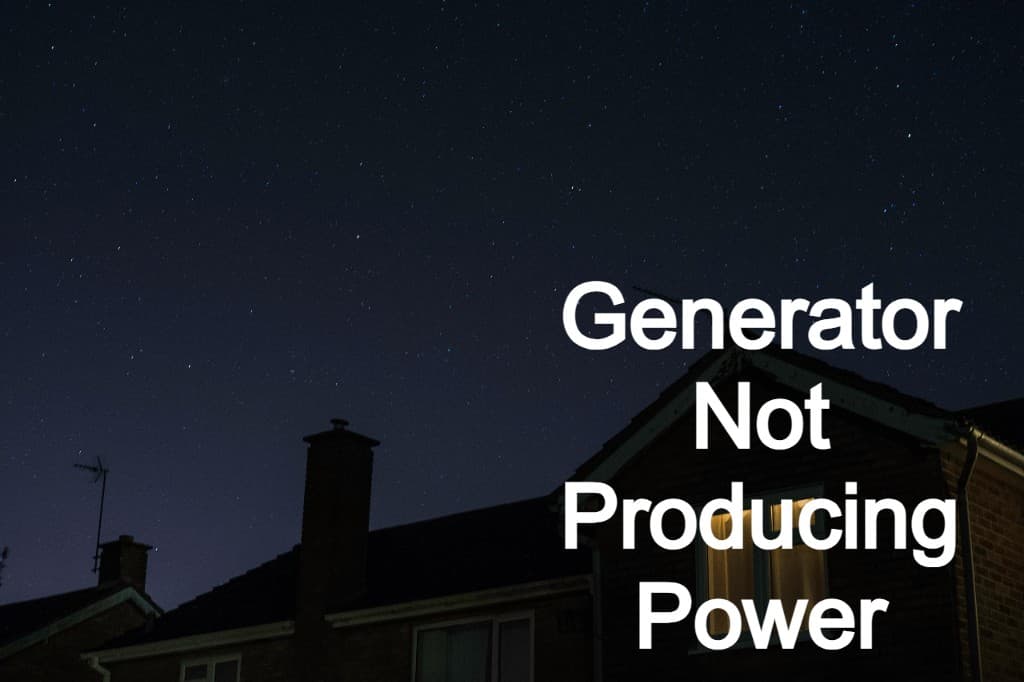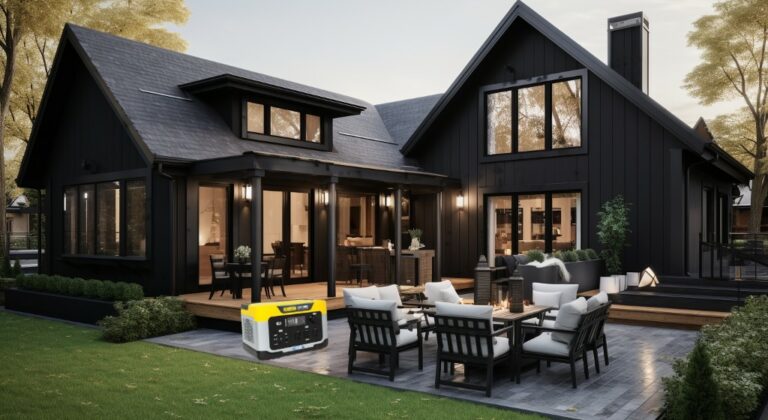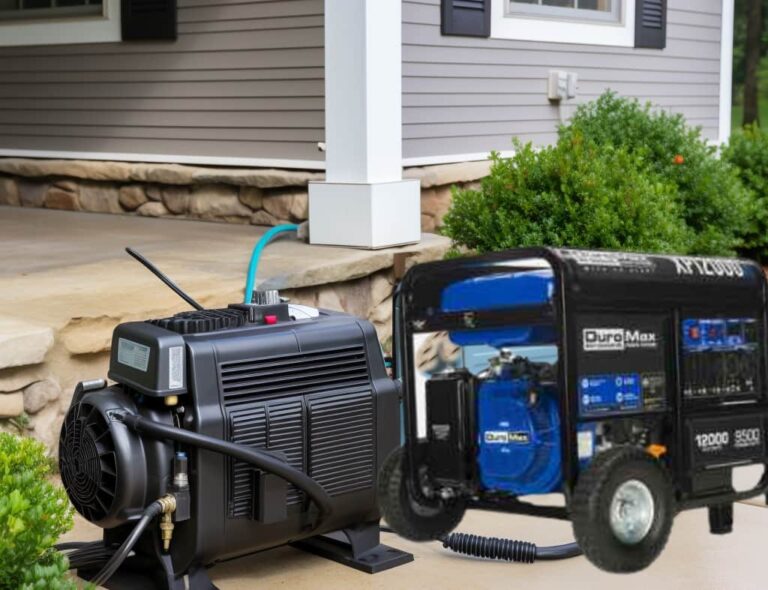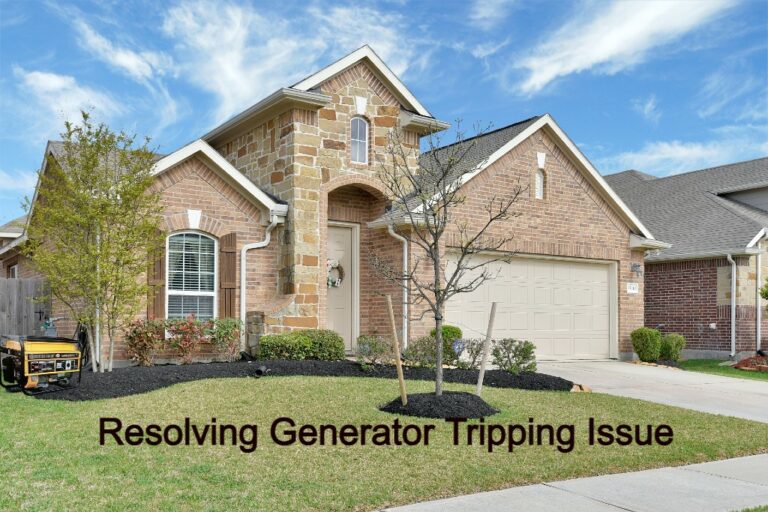Is Your Generator Not Producing Power? Here Is Why

Is your generator experiencing a power outage? Let’s explore the reasons behind this issue.
Various factors could contribute to your generator’s failure to produce power. In the following discussion, we will delve into the top common causes and offer solutions to help you resolve the problem.
We will cover all the important aspects, from a faulty AVR to a tripped breaker. So, if you are curious about the reasons behind your generator’s malfunction, continue reading to discover the answers.
Top Reasons Your Generator May Not Be Producing Power
If your generator isn’t producing power, one potential reason could be a defective fuel supply. It’s vital to check that an adequate amount of fuel is present in the tank and that it’s reaching the engine effectively.
An obstructed air filter is another possible cause of a generator’s lack of power generation. A soiled air filter can restrict airflow and result in the malfunctioning of the generator. To rectify this issue, you can cleanse or replace the air filter.
Additionally, a generator may fail to produce power if the spark plug is faulty or worn out. Inspecting and replacing the spark plug can assist in resolving this problem.
Another prevalent problem is a low oil level. If the generator doesn’t contain enough oil, it may automatically shut off to prevent damage. It’s essential to check the oil level and refill it regularly.
Other factors that can contribute to a generator’s failure to produce power include:
- Tripped circuit breaker
- Defective control board
- Broken or loose wire connection
- Malfunctioning voltage regulator
- Defective generator motor.
Troubleshooting these issues may require professional assistance or consulting the generator’s manual.
How to Test and Fix a Generator that has Low Voltage on one phase, 400V, 3 Phase Alternator
To examine and fix a generator with low voltage on one phase, you can begin by scrutinizing the connections and ensuring their security. Here’s a step-by-step guide to assist you in troubleshooting and resolving the issue:
- Inspect the connections: Commence by scrutinizing the wiring connections of the generator. Look for any loose or damaged wires causing a weak connection. Tighten or replace any faulty connections you discover.
- Measure the voltage: Utilize a multimeter to gauge the voltage reading on each generator phase. This will aid in determining if the low voltage is confined to a specific phase or if it impacts the entire generator.
- Check the voltage regulator: If the low voltage is only present on one phase, the issue may lie with the voltage regulator. Inspect the regulator for any indications of damage or malfunctions. Substitute the regulator if necessary.
- Consider a power outage: If you’ve recently encountered a power outage, there may be an issue with the utility power supply. Get in touch with your local utility company to ascertain if there are any known issues in your vicinity.
AVR defective (Automatic Voltage Regulator)
Inspecting the Automatic Voltage Regulator (AVR) is the next step in troubleshooting your brushless generator. The AVR may be defective if the generator isn’t producing power or the output voltage is unstable. Begin by examining the AVR for any visible signs of damage, such as burnt components or loose connections. If no damage is apparent, you can utilize a multimeter to test the AVR. It’s crucial to adhere to the testing procedures provided by the manufacturer.
If it’s determined that the AVR is indeed defective, it will be necessary to replace it to restore your generator’s functionality. Contact the manufacturer or a qualified technician to obtain a compatible AVR for your generator model. Installing a new AVR should rectify the output voltage issue and enable your generator to produce power again.
After inspecting and potentially replacing the AVR, it’s crucial to investigate any other potential problems. A tripped breaker or blown fuse is a common issue that can result in a generator failing to generate power. This can often occur due to overload, a short circuit in the generator, or the connected load. The subsequent section’ll discuss troubleshooting and resetting a tripped breaker or blown fuse to get your generator operational.
Tripped Breaker (Fuse)
Check the circuit breaker panel for any tripped breakers or blown fuses. This is a frequent reason why your generator may not be producing power. Here are a few things to inspect:
- Tripped breaker: Examine for any breakers that are in the ‘off’ position. If you come across one, attempt flipping it back to the ‘on’ position. Sometimes, during a power surge or overload, the breaker may trip to safeguard the circuit.
- Blown fuse: Inspect the fuses in the circuit breaker panel. If you notice a fuse with a broken filament or appears burnt, it may need replacing. Turn off the generator before replacing the fuse to avoid any electrical hazards.
- Overloaded circuits: If multiple appliances or devices are connected to your generator, the circuits may be overloaded. Try disconnecting some devices and see if the power comes back on. If it does, you may need to redistribute the load or consider using a larger generator.
- Generator switch: Ensure that the generator switch is in the ‘on’ position. Sometimes, it can accidentally get switched off, causing a loss of power.
Remember to always turn off the generator before attempting any troubleshooting or maintenance. Safety should be your top priority.
Read Causes And Solutions For Smoke Coming From Generator
Frequently Asked Questions
What Are the Common Signs of a Generator Not Producing Power?
You may observe several common indications if your generator fails to produce power. These include the absence of any functioning lights or appliances, complete silence emanating from the generator, and a dearth of fuel or a malfunctioning fuel supply system.
To explore this matter further, let us investigate the signs that signify a generator’s failure to generate power. Firstly, one might observe a complete absence of any lights or appliances functioning. This absence of electrical activity can be quite disconcerting and may leave one pondering the cause of such a predicament.
Secondly, in the light of a generator not producing power, one might notice an eerie silence emanating from the machinery. The lack of mechanical noise can be quite perplexing, primarily if the generator had operated smoothly before this sudden silence.
Thirdly, a lack of fuel or a broken fuel supply can also contribute to a generator’s failure to produce power. The absence of fuel or a malfunctioning fuel supply system can significantly impact the generator’s ability to generate electrical power. It is crucial to ensure that the fuel supply is intact and functional.
However, it is important to mention that these signs are not the only indicators of a generator’s failure to produce power. Other factors may be at play, such as a malfunctioning electrical system or a damaged generator component. These factors should also be taken into consideration when troubleshooting the issue.
How Can I Check if My Generator’s Fuel Supply Is Causing the Lack of Power Production?
To determine if your generator’s fuel supply is causing the lack of power production, start by verifying that there is ample fuel in the tank. If the fuel level is low or depleted, replenish it and observe if the generator initiates power generation.
Are There Any Specific Maintenance Procedures I Should Follow to Prevent My Generator From Losing Power Production?
It is crucial to adhere to specific maintenance procedures to prevent your generator from experiencing a decline in power production. Begin by thoroughly examining and purifying the fuel supply, scrutinizing and replacing worn-out components, and ensuring adequate ventilation and cooling.
Delving into the details of generator maintenance, it becomes apparent that regular inspection and cleansing of the fuel supply are of utmost importance. This task should not be overlooked, as a contaminated fuel supply can significantly hinder the generator’s power output. Likewise, inspecting and replacing parts that show signs of wear and tear is of equal significance. Neglecting this aspect can lead to a decrease in the overall efficiency and performance of your generator.
Furthermore, ensuring proper ventilation and cooling are equally essential maintenance measures. A generator without sufficient ventilation and cooling can experience a decline in power production. It is important to guarantee that the generator is placed in a well-ventilated area, allowing for adequate air circulation. Additionally, cooling mechanisms, such as fans or heat sinks, can enhance the generator’s operational efficiency.
Can Extreme Weather Conditions Affect a Generator’s Power Output?
Extreme weather conditions can indeed impact the power output of your generator. Severe winds, heavy rainfall, or extreme temperatures have the potential to cause harm to the generator’s components or disrupt the fuel supply, resulting in a loss of power production.
It is important to note that adverse weather conditions can uniquely damage the generator’s functionality. High winds, for instance, can cause significant harm, while heavy rain can disrupt the generator’s performance equally. On the other hand, extreme temperatures can uniquely affect both the components and the fuel supply.
Moreover, adverse weather conditions can also lead to a loss of power output. This is because the damage caused by the weather can disrupt the generator’s ability to produce electricity. In addition, the fuel supply disruption can further exacerbate the loss of power production.
Furthermore, it is crucial to consider the impact of adverse weather conditions on the generator’s power output. High winds and heavy rain can cause damage, and extreme temperatures can also have a detrimental effect. Therefore, it is important to consider these factors when considering the performance of your generator.
What Are Some Troubleshooting Steps I Can Take if My Generator Is Not Producing Power Despite Everything Else Appearing to Function Properly?
If your generator is not generating power despite all other systems operating correctly, there could be several possible causes. First, it is important to examine the fuel level and then inspect the spark plug and wiring connections.
It is worth mentioning that there are other factors to consider in this scenario. Firstly, it is crucial to ensure that the generator’s fuel tank has adequate fuel. Secondly, it is equally important to meticulously examine the spark plug for any signs of damage or wear. Additionally, it is advisable to thoroughly inspect the wiring connections for any loose or disconnected wires.
Furthermore, delving into other potential causes affecting the generator’s power output is essential. For instance, a faulty voltage regulator or a malfunctioning alternator can also lead to a lack of power generation. Likewise, a damaged or worn-out generator rotor could also be a contributing factor.
Conclusion
If your generator isn’t producing power, there could be various reasons for this issue. Some common causes include a defective AVR (Automatic Voltage Regulator) or a tripped breaker (fuse).
It’s crucial to test and fix these problems to ensure the proper functioning of your generator. By addressing these issues, you can restore the power output of your generator and ensure a reliable source of electricity.





